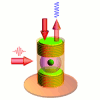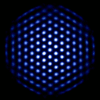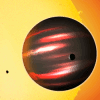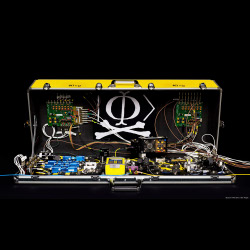-
Viewpoint on 'IONS'
Viewpoint on 'Scientific Literacy'
- Proudly sponsored by
-


-
Sailing through the Waves of Light

The difference in the interaction between an atom and light can be as wide as that between a pleasant, relaxing canoe ride, and a whitewater rafting experience. It is now possible to switch back and forth between the two, ultraquickly, at the touch of a laser pulse.
-
A Wind Tunnel for Quantum Physics

Simulating quantum phenomena on today’s computers can be extremely challenging. Yet, just like the wind tunnel changed the trajectory of modern aviation, new specially built quantum simulators may soon guide the design of tailor-made quantum materials.
-
Light from the Darkest Planet

The composition of exoplanets can be inferred from their reflected light. But, what if a planet is far darker than we had ever thought possible?
Volume 16 Story 1 - 4/1/2012

Now also in Spanish
QSI: Investigación de la escena cuántica
and Portuguese
QSI: Investigação Quântica,
brought to you by
Optics and Photonics Latin America
A body is discovered: was it an accident? Or was it murder? A forensic scientist investigating a suspected murder case has to be able to discern between evidence that is real and useful, and evidence that is circumstantial or purely coincidental. The same is true for scientists investigating quantum effects: sometimes experiments may appear to show quantum behavior even when this is not really quantum. Therefore, it is key to distinguish between the experiments that can be explained using classical physics and those that cannot. For many years, this has been done using Bell-tests. However, an international team led by Christian Kurtsiefer at the National University of Singapore has recently shown how it is possible to cheat in these tests: they managed to make a classical system pass off as a quantum system. This highlights the importance of meticulously understanding the detection devices when studying quantum effects, and has technological implications.
In the beginning of the twentieth century, the foundations of our physical understanding of nature underwent deep changes. On the one hand, Einstein’s theory of relativity suddenly linked space and time, introducing the speed of light as an objective maximum speed. On the other hand, quantum mechanics postulated that certain physical properties cannot be measured with arbitrary precision and that our classical concepts of waves and particles have to be refined to accurately describe nature. Both theories were tremendously successful in describing and predicting important experimental results. At the same time, however, the two theories were totally contradictive in many ways. Not surprisingly, and as a result, some of the greatest physicists of the time engaged in a vivid debate on how to ultimately describe nature, trying to identify weaknesses in one model or the other.
Some predictions of quantum mechanics seemed so strange that scientists questioned quantum mechanics as a whole. In 1935, Albert Einstein, Boris Podolsky and Nathan Rosen [1] famously doubted that quantum mechanics was a complete theory, suggesting that it was more likely to be a temporary theory that glanced over some yet-unknown underlying mechanisms. In fact, they pointed out that, according to quantum physics, two distant particles can influence each other instantaneously. Such instantaneous correlation at a distance, however, seemed to directly contradict Einstein’s theory of relativity, which postulates that no signal can travel faster than the speed of light. Owing to the names of the three physicists, this contradiction became known as the EPR paradox. For many years, however, it was widely regarded as a rather philosophical question since nobody was able to design a feasible experiment that could study this case.
In 1964, John Bell showed how to determine whether a quantum experiment behaves like a classical system with “hidden variables” or like a genuine quantum system [2]. Put simply, hidden variables of a physical system are properties that are not accessible to an experimenter. The correlation between two quantum particles is different for a classical hidden variable model and for the quantum model. From this difference, Bell was able to distill an inequality that is satisfied for any classical hidden variable model. A genuine quantum system, however, can violate the Bell inequality.
Scientists finally had a way to determine whether or not experiments — as predicted by Einstein, Podolsky and Rosen — could be described by classical local hidden variable models. However, these experiments were so delicate and challenging that it took almost another 20 years for convincing experimental results to be accomplished. Since then, these genuine quantum correlations — called entanglement — have increasingly taken center stage in quantum research. After all, entanglement is one of the most profound differences between classical and quantum physics. Therefore, Bell tests and its derivatives have become the standard approach for discerning between entangled and classically correlated systems in countless experimental setups.
Nevertheless, "Bell-tests with photons have loopholes," Christian Kurtsiefer explains. "On the one hand, we use detectors that have rather limited efficiencies. Therefore, we have to assume that the photons that we do measure have the same probability distributions and correlations as the photons that we missed. This is called the detection loophole — and it is enough to make us reconsider our experimental observations of entangled photons and to destroy the security of several quantum communication protocols." In fact, all current Bell-test experiments with photons involve considerable losses: photons are lost in fiber-optic cables or free-space transmission lines, and photodetectors only measure a certain percentage of incident photons. For many years, many scientists thought that discussions regarding loopholes were essentially philosophical questions without practical relevance. However, recent reports on the successful hacking of commercial quantum cryptography systems [4] proved the opposite to be true.
Kurtsiefer’s team reproduced apparent quantum behavior using only classical light by exploiting weaknesses in the photodetectors. "It is possible to control the measurements registered by our photodetectors using strong light pulses. In fact, these detectors only register photon or no photon – they do not count the number of photons. Moreover, once they have detected a photon, it takes some time for them to reset, and during this time they cannot detect any further photons. By using strong laser pulses with many photons we can make sure that the detectors measure our forged photons. Also, strong laser pulses allow us to deliberately shut down the photons whenever we do not want them to measure anything. In this way, we can obtain full control over the outcome of the measurement and therefore create any result we want — including a Bell test that shows entangled photons even though we only use classical light."
"Until recently, cheating Bell tests by exploiting the detection loophole was a purely hypothetical exercise," Paul Kwiat [5] from the University of Illinois at Urbana-Champaign (USA) says. "The fact that people have now been able to use present-day technology to spoof the detectors and thus to produce fake Bell-inequality violations serves as a strong additional motivation to seriously consider making loophole-free Bell-tests. Thus, Kurtsiefer’s and other’s results [6] highlight the importance of knowing our underlying hypothesis about our equipment. In fact, the only way for us to make definitive statements about the laws of nature is if we have unambiguous experiments. This becomes particularly important as quantum technologies are making their way towards applications like quantum cryptography, where there is the very real possibility of an adversary that wants to mislead us — we are thus required to consider the robustness of our approaches very carefully."
[1] A. Einstein, B. Podolsky & N. Rosen, Can Quantum-Mechanical Description of Physical Reality be Considered Complete? Phys. Rev. 47, 777-780 (1935).
[2] J. Bell, On the Einstein Podolsky Rosen Paradox, Physics 1, 195-200 (1964).
[3] A. Niederberger, Visible and Entangled, Opt. Photon. Focus 3, 7 (2008). http://www.opfocus.org/index.php?topic=story&v=3&s=7
[4] L. Lydersen et al., Hacking commercial quantum cryptography systems by tailored bright illumination, Nat. Photon. 4, 686-689 (2010); G. Adamo, Hack Me If You Can, Opt. Photon. Focus 12, 4 (2011). http://www.opfocus.org/index.php?topic=story&v=12&s=4
[5] P. G. Kwiat et al., New high-intensity source of polarization-entangled photon pairs, Phys. Rev. Lett. 75, 4337-4341 (1995); J. B. Altepeter, E. Jeffrey & P. G. Kwiat. Phase-compensated ultra-bright source of entangled photons, Opt. Express 13, 8951-8958 (2005).
[6] J Barrett & N. Gisin, How Much Measurement Independence Is Needed to Demonstrate Nonlocality? Phys. Rev. Lett. 106, 100406 (2011).

QSI: Quantum Scene Investigation
What do police detectives and quantum physicists have in common? They both often need to interpret evidence, and distinguish between false and real clues. After all, evidence pointing to a quantum phenomenon can be rigged, just like evidence pointing to a crime suspect can.
Quantum hacker’s toolkit. A toolbox small enough to fit in a suitcase is enough to counterfeit quantum measurements. Image credit: NTNU Info / Geir Mogen.
QSI: Investigación de la escena cuántica
and Portuguese
QSI: Investigação Quântica,
brought to you by
Optics and Photonics Latin America
A body is discovered: was it an accident? Or was it murder? A forensic scientist investigating a suspected murder case has to be able to discern between evidence that is real and useful, and evidence that is circumstantial or purely coincidental. The same is true for scientists investigating quantum effects: sometimes experiments may appear to show quantum behavior even when this is not really quantum. Therefore, it is key to distinguish between the experiments that can be explained using classical physics and those that cannot. For many years, this has been done using Bell-tests. However, an international team led by Christian Kurtsiefer at the National University of Singapore has recently shown how it is possible to cheat in these tests: they managed to make a classical system pass off as a quantum system. This highlights the importance of meticulously understanding the detection devices when studying quantum effects, and has technological implications.
In the beginning of the twentieth century, the foundations of our physical understanding of nature underwent deep changes. On the one hand, Einstein’s theory of relativity suddenly linked space and time, introducing the speed of light as an objective maximum speed. On the other hand, quantum mechanics postulated that certain physical properties cannot be measured with arbitrary precision and that our classical concepts of waves and particles have to be refined to accurately describe nature. Both theories were tremendously successful in describing and predicting important experimental results. At the same time, however, the two theories were totally contradictive in many ways. Not surprisingly, and as a result, some of the greatest physicists of the time engaged in a vivid debate on how to ultimately describe nature, trying to identify weaknesses in one model or the other.
Some predictions of quantum mechanics seemed so strange that scientists questioned quantum mechanics as a whole. In 1935, Albert Einstein, Boris Podolsky and Nathan Rosen [1] famously doubted that quantum mechanics was a complete theory, suggesting that it was more likely to be a temporary theory that glanced over some yet-unknown underlying mechanisms. In fact, they pointed out that, according to quantum physics, two distant particles can influence each other instantaneously. Such instantaneous correlation at a distance, however, seemed to directly contradict Einstein’s theory of relativity, which postulates that no signal can travel faster than the speed of light. Owing to the names of the three physicists, this contradiction became known as the EPR paradox. For many years, however, it was widely regarded as a rather philosophical question since nobody was able to design a feasible experiment that could study this case.
In 1964, John Bell showed how to determine whether a quantum experiment behaves like a classical system with “hidden variables” or like a genuine quantum system [2]. Put simply, hidden variables of a physical system are properties that are not accessible to an experimenter. The correlation between two quantum particles is different for a classical hidden variable model and for the quantum model. From this difference, Bell was able to distill an inequality that is satisfied for any classical hidden variable model. A genuine quantum system, however, can violate the Bell inequality.
Scientists finally had a way to determine whether or not experiments — as predicted by Einstein, Podolsky and Rosen — could be described by classical local hidden variable models. However, these experiments were so delicate and challenging that it took almost another 20 years for convincing experimental results to be accomplished. Since then, these genuine quantum correlations — called entanglement — have increasingly taken center stage in quantum research. After all, entanglement is one of the most profound differences between classical and quantum physics. Therefore, Bell tests and its derivatives have become the standard approach for discerning between entangled and classically correlated systems in countless experimental setups.
Nevertheless, "Bell-tests with photons have loopholes," Christian Kurtsiefer explains. "On the one hand, we use detectors that have rather limited efficiencies. Therefore, we have to assume that the photons that we do measure have the same probability distributions and correlations as the photons that we missed. This is called the detection loophole — and it is enough to make us reconsider our experimental observations of entangled photons and to destroy the security of several quantum communication protocols." In fact, all current Bell-test experiments with photons involve considerable losses: photons are lost in fiber-optic cables or free-space transmission lines, and photodetectors only measure a certain percentage of incident photons. For many years, many scientists thought that discussions regarding loopholes were essentially philosophical questions without practical relevance. However, recent reports on the successful hacking of commercial quantum cryptography systems [4] proved the opposite to be true.
Kurtsiefer’s team reproduced apparent quantum behavior using only classical light by exploiting weaknesses in the photodetectors. "It is possible to control the measurements registered by our photodetectors using strong light pulses. In fact, these detectors only register photon or no photon – they do not count the number of photons. Moreover, once they have detected a photon, it takes some time for them to reset, and during this time they cannot detect any further photons. By using strong laser pulses with many photons we can make sure that the detectors measure our forged photons. Also, strong laser pulses allow us to deliberately shut down the photons whenever we do not want them to measure anything. In this way, we can obtain full control over the outcome of the measurement and therefore create any result we want — including a Bell test that shows entangled photons even though we only use classical light."
"Until recently, cheating Bell tests by exploiting the detection loophole was a purely hypothetical exercise," Paul Kwiat [5] from the University of Illinois at Urbana-Champaign (USA) says. "The fact that people have now been able to use present-day technology to spoof the detectors and thus to produce fake Bell-inequality violations serves as a strong additional motivation to seriously consider making loophole-free Bell-tests. Thus, Kurtsiefer’s and other’s results [6] highlight the importance of knowing our underlying hypothesis about our equipment. In fact, the only way for us to make definitive statements about the laws of nature is if we have unambiguous experiments. This becomes particularly important as quantum technologies are making their way towards applications like quantum cryptography, where there is the very real possibility of an adversary that wants to mislead us — we are thus required to consider the robustness of our approaches very carefully."
[1] A. Einstein, B. Podolsky & N. Rosen, Can Quantum-Mechanical Description of Physical Reality be Considered Complete? Phys. Rev. 47, 777-780 (1935).
[2] J. Bell, On the Einstein Podolsky Rosen Paradox, Physics 1, 195-200 (1964).
[3] A. Niederberger, Visible and Entangled, Opt. Photon. Focus 3, 7 (2008). http://www.opfocus.org/index.php?topic=story&v=3&s=7
[4] L. Lydersen et al., Hacking commercial quantum cryptography systems by tailored bright illumination, Nat. Photon. 4, 686-689 (2010); G. Adamo, Hack Me If You Can, Opt. Photon. Focus 12, 4 (2011). http://www.opfocus.org/index.php?topic=story&v=12&s=4
[5] P. G. Kwiat et al., New high-intensity source of polarization-entangled photon pairs, Phys. Rev. Lett. 75, 4337-4341 (1995); J. B. Altepeter, E. Jeffrey & P. G. Kwiat. Phase-compensated ultra-bright source of entangled photons, Opt. Express 13, 8951-8958 (2005).
[6] J Barrett & N. Gisin, How Much Measurement Independence Is Needed to Demonstrate Nonlocality? Phys. Rev. Lett. 106, 100406 (2011).
Armand Niederberger
2012 © Optics & Photonics Focus
AN is a SU2P Research Fellow working on quantum networks at Stanford University, California, USA.

Ilja Gerhardt, Qin Liu, Antía Lamas-Linares, Johannes Skaar, Valerio Scarani, Vadim Makarov & Christian Kurtsiefer, Experimentally Faking the Violation of Bell’s Inequalities, Physical Review Letters (2011) 107, 170404 (link).